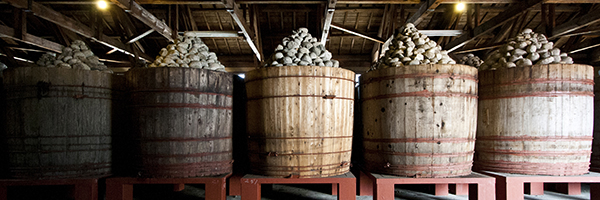
In central Japan’s Aichi Prefecture, in the town of Okazaki, on the former site of Hatcho Village, is a curious set of old, somewhat churchlike buildings. They are the home of Hatcho Miso Company, Ltd., makers for five centuries of one of Japan’s true living treasures, the most revered miso in all Japan.
Under the ancient rafters of the shop stand rows of huge cedar vats, held together with hoops of braided bamboo. Most of these vats have been in use for over a hundred years, with the most venerable pushing the ripe old age of 175. Each one is topped with a mountain of stones so skillfully arranged that they never collapse, even during earthquakes. In each vat, under the pressure of three tons of river rocks, 12,000 pounds of Hatcho (pronounced hot-cho) Miso slowly and naturally ferments through the hot, humid summers and mild Aichi winters. After 24 to 30 months, under the direction of their nineteenth generation president Kyuemon Hayakawa, workers remove the stones and pressing lid, revealing the rich, fragrant miso that has long been treasured by emperors, shoguns, and common people alike.
Hatcho Miso Company’s rise to fame began in the late 16th century. Okazaki was the birthplace of Japan’s most famous warlord, Ieyasu Tokugawa, whose military exploits were popularized in the novel Shogun, by James Clavel, and the television mini-series by the same name. In the shadows of Tokugawa’s castle, a small soybean miso shop supplied the vital ingredient for the shogun’s power breakfast. Because of its concentrated nutrition and its ability to keep for years, Tokugawa’s miso was one of his troops’ most important military rations. After his army succeeded in conquering and unifying all of Japan, Tokugawa moved his headquarters to Tokyo and, until his death, ordered miso from his hometown miso shop.
In 1901, Hatcho Miso Company received the even more prestigious honor of becoming the purveyor to the emperor of Japan. Today, busloads of tourists visit the company’s Hatcho Village Store to see where the emperor’s and shogun’s miso is made. However, you don’t have to be a samurai, or even live in Japan, to enjoy Hatcho Miso. Since 1971, Mitoku has been exporting this same miso to natural food distributors around the world.


